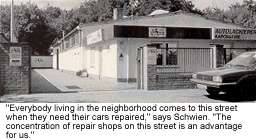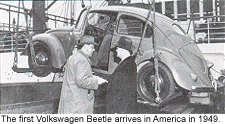If you’re in search of Cinderella, Hansel and Gretel, the Pied Piper or Rumpelstiltskin, Germany’s Fairy Tale Road is the place to look. One of Germany’s special tourist routes, the road leads through parts of the country where the brothers Grimm — legendary children’s authors — lived and worked.
If, instead, you’re looking for an exhilarating, corner-hugging speed-induced high on the open road, head to the autobahnen — Germany’s infamous motorways — where the suggested speed limit is 130 kph (80 mph). Vroom, vroom!
Germany is covered by a modern network of autobahnen that extends more than 8,700 miles, making it one of the densest areas in the world. A total of 303,000 miles of roadway wind through picturesque villages, lush countryside and flourishing cities, making every area of the country reachable to motorists.
It’s this vast network of roadways — and the aggressive driving habits of Germans — that keep 33,900 German body shops, like Schwien GmbH in Berlin, in business.

German Engineered
Motorists in Berlin who turn onto Beriepschstrasse either live in one of the neat, two-story houses or are looking for a professional body shop. Apart from the appointed Daimler-Benz, Saab and Fiat dealers, several independent body shops can be found lining the street.
"Everybody living in the neighborhood comes to this street when they need their cars repaired," says Joachim Schwien, shop manager for Schwien GmbH, an independent, or unaffiliated, body shop. "The concentration of repair shops on this street is an advantage for us."
A trained auto painter, Schwien manages the shop with his wife, Brigitte, who’s the company’s managing director. Employing four painters and one "body builder," the shop is the average size for a German body shop.
An average of 200 cars per month are repaired at Schwien GmbH. To accommodate such a workload, a painter works in the spraybooth for the entire day. "This is really a tough job," says Schwien. "Therefore the painters take turns every three weeks."
The shop is equipped with a downdraft combination spray and drying booth with an adjacent backing oven, which is connected by a gate. After a vehicle is painted, it’s simply pushed from the spraybooth into the oven, which has a constant temperature of 176 degrees F. This setup allows the painter to spray the next car while the first one is still drying, and it’s the only way the body shop can manage the required 12 vehicles per day.
To speed up the preparatory work, Schwien sometimes uses an infrared heater to make the stopper, or primer, dry quicker. But infrared heat is never used to dry the paint finish. "That’s much too expensive since the dryers use so much electricity," says Schwien. "The spraybooth and the oven are oil heated, which has been the most cost-efficient solution to date."
The 1,800-square-foot repair shop is equipped with everything a modern body shop needs, including a welding machine, a fixed spot welder, bodywork tools, a mixing machine, a distilling device, a gun-cleaning machine, masking material and protective gear for the staff. The shop can accommodate 12 vehicles at a time, which are worked on in a parallel fashion.
A 300-square-foot office, where Schwien and his wife work, is situated in front of the repair shop. Schwien is the contact person for customers and damage appraisers, while his wife does the bookkeeping and handles all other commercial tasks.
Schwien purchased the shop — which originally was simply a paint-refinishing facility — in 1988 from Daimler-Benz. All the employees stayed on, and the only thing Schwien changed was the paint supplier.
"At the time, we still had several paint suppliers," says Schwien. "But when paint, thinners and hardeners from different manufacturers are used, it can cause defects in the finish." To eliminate this potential source of defects, the company chose Standox as its sole supplier. "We’ve been and are satisfied with our choice," he says. "The paint is good, and so is the service. Standox also regularly offers free training courses and seminars."
Business in Berlin
In 1994, the Schwiens made further alterations to their shop. "The mid-’90s were lean years for the refinishing industry in Berlin. Says Brigitte, "We even incurred losses at the time."
After Germany’s re-unification, many appointed dealers built new, larger body shops, which included paint shops, in the Berlin area. This cut Schwien’s sales by close to DM 30,000 (deutschmarks) or $16,500. To compensate for this decline, they acquired the adjourning premises and buildings, employed a body builder and were able to offer entire crash repairs. This reduced the shop’s reliance on car dealerships, since body and paint repairs for private customers could now be contracted to a greater degree. The plan worked out well for Schwien.
The decline in revenues was offset by additional income from private customers, who now account for half the current revenue. Except for the mid-’90s, the shop’s business figures haven’t changed much. "Since 1988, we’ve generated average annual revenues of DM 1 million [$550,000]," says Schwien. "Ancillary costs, especially the shop rent, have increased, so we’re looking at a gross profit of approximately 10 percent at year’s end."
To achieve this profit, Schwien and his wife must calculate costs very carefully — since raising prices would mean losing business. A collision body repair costs between DM 2,000 and 4,000 ($1,100 and $2,200); an overall re-spray can cost DM 5,000 ($2,750) or higher, depending on the size and condition of the car. These prices include paint materials — complete with stopper (primer) and hardener — which account for about 30 to 35 percent.
Schwien pays his employees DM 25 ($13.75) an hour, which is more than the collectively agreed hourly wages for painters and body technicians, which are about DM 23 ($12.65) in Berlin. Average overall monthly wages are DM 6,600 ($3,630) in the Western part of Germany and DM 5,300 ($2,915) in the Eastern part.
In Germany, collective bargaining is permitted and is a common practice. This situation is particularly precarious in Germany, where different collective wages are being paid in the Eastern and Western parts. Collective wages in former East German regions amount to only DM 19 ($10.45), which means work can be done much cheaper there. Instead of raising Eastern wages to the Western level, proposals have been made to lower Western wages.
Independent Issues
In Berlin, carmakers have begun building giant refinishing centers, where people work in three shifts for approximately DM 18 ($9.90) per hour. The carmaker dealerships then act as intermediaries, passing customers’ cars on to the big refinishing shops and handing them back to the customers after the repair. For obvious reasons, such dealerships no longer need body technicians or painters. This trend isn’t confined to the Berlin area, and can be observed elsewhere in Germany. For independent body shops that work for car dealers, it means losing work.
One possibility to compensate for this loss is to cooperate with insurance companies. In Germany, auto insurers aren’t allowed to dictate where policyholders have their cars repaired. But, there are ways to influence them. First, insurers may ask their clients to pay part of the costs if they choose a more expensive body shop rather than a cheaper shop proposed by the insurer. Second, insurers often secure cooperation deals with certain body shops. These shops — usually small to medium in size — will contract jobs from the insurer and, in turn, are obliged to offer customers rescue and towing service, as well as courtesy cars — all at their own expense.

Overseas Similarities
With 33,900 repair facilities and 81.5 million inhabitants in an area roughly half the size of Texas, the competition for repair work can be fierce in Germany — much like it is in the United States.
But Schwien is positive. "I think you can call the refinishing industry profitable because business is stable," he says. (In 1997, DM 20.71 billion or $11.39 billion was spent on collision repair and refinishing in Germany.)
Unlike the industry in America, the German collision repair industry enjoys a good reputation among consumers. But Schwien finds this a bit surprising.
"I don’t know what the situation looks like elsewhere in Germany, but here in Berlin there are many backyard shops among the repair facilities.," he says. Though shops like these have great difficulty meeting the high safety and environmental standards established in Germany and can’t offer traditional German-quality work, backyard shops still survive. (Sound familiar?)
"There’s a market for this type of cheap repair work," says Schwien. "The car has long since ceased to be the Germans’ favorite toy. Holidays have become No. 1 followed by family lifestyle. The car now ranks third.
"This is something we notice in our day-to-day work," he says. "Even some fairly rich customers try to save money when it comes to their cars. [Sometimes], they prefer to drive around with a dent instead of having it repaired. And when they finally turn up, they start to bargain [with us]."
Though it’s vehicle owners — rather than insurers — bargaining with repair shops in Germany, the outcome is the same. It seems shops are fighting for profits no matter what side of the Atlantic they’re on.
Information provided by Standox.

The VW Beetle Comes to America The date was April 1949, and the businessman was Heinrich Nordhoff, head of Volkswagen, Inc. It was Nordhoff’s deft marketing skills that turned the "thingamajig" — the VW Beetle — into an overnight sensation and a German bestseller even in the heart of Chevrolet and Cadillac country. Proving those early customs officers wrong, Volkswagen sold no fewer than 5 million Beetles in the United States. By 1972, Volkswagen had surpassed the sales record set by Henry Ford’s "Tin Lizzy," of which 15 million units were sold. In the end, more than 20 million Beetles, which were exported to 147 countries, were produced — a world record that still stands.
Source: Insight Guides: Germany. |
|
The Finger and Other Banned Gestures "It comes from the average German’s belief that they’re excellent drivers while everyone else on the road is an execrable one and that the average German’s highly conservative daytime role creates a ‘King of the Road’ mentality after leaving the workplace," says Oliver Bengl, a professional driver. Road rage in Germany became so serious that authorities stepped in and made any sort of offensive gesture illegal. If you give another driver "the finger," both British and American versions; tap your temple with your index finger; wave an inward-turned open palm up and down in front of your eyes; raise a fist; or even give an Italian-style under-the-chin finger flick, the person at whom the gesture is directed can write down your registration number and report you to the police. Once a report is made, you can be fined up to DM 1,500 or $825.
Source: Lonely Planet: Germany. |
|
In a Jam Driving at 80 mph or faster down the highway may sound like a dream, but like American motorists, German drivers often have to hit the brakes because of traffic jams (staus). Traffic jams are a subject of intense interest to motorists in Germany and are the focus of typical German thoroughness: You can actually get an annual Traffic Jam Calendar from the Allgemeiner Deutscher Automobil Club, a German motoring organization. German radio stations also broadcast a special tone that interrupts cassette and CD players during traffic reports. But normal traffic jams are nothing when compared to the astounding "traffic jam from nowhere" (stau aus dem nichts). Drivers can be sailing along at 180 kph and suddenly find themselves screeching to a halt and taking the next 8, 10 or even 30 kilometers at a crawling pace. What’s most frustrating is, most of the time, traffic just speeds up again and you never see what caused the backup in the first place. These "traffic jams from nowhere" are so prevalent that the German government actually funded a study of the phenomenon. |













